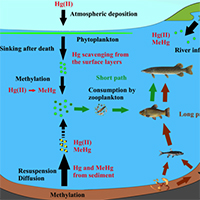Mercury methylation in oxic aquatic macro-environments: a review

Accepted: 27 February 2021
HTML: 106
All claims expressed in this article are solely those of the authors and do not necessarily represent those of their affiliated organizations, or those of the publisher, the editors and the reviewers. Any product that may be evaluated in this article or claim that may be made by its manufacturer is not guaranteed or endorsed by the publisher.
Authors
Mercury methylation in aquatic environments is a key process that incorporates this neurotoxin into the food chain and ultimately the human diet. Mercury methylation is considered to be essentially biotic and mainly driven by sulfate-reducing bacteria present in the bottom sediments in aquatic systems. However, in recent decades, many researchers have shown that this methylation also occurs in oxic layers in conjunction with a high content of particulate organic matter and localized depletion of dissolved oxygen. The goals of this review are to summarize our current understanding of Hg methylation in water columns of both marine and freshwater environments, as well as to highlight knowledge gaps and future research needs. Most of the literature showed that suspended particles (known as marine and lake snow) could be the microenvironment in which Hg methylation could occur across oxic water columns, because they have been recognized as a site of organic matter mineralization and as presenting oxygen gradients around and inside them. To date, the majority of these studies concern marine environments, highlighting the need for more studies in freshwater environments, particularly lacustrine systems. Investigating this new methylmercury production environment is essential for a better understanding of methylmercury incorporation into the trophic chain. In this review, we also propose a model which attempts to highlight the relative importance of a MeHg epilimnetic path over a MeHg benthic-hypolimnetic path, especially in deep lakes. We believe that this model could help to better focus future scientific efforts in limnic environments regarding the MeHg cycle.
Edited by
Diego Fontaneto, CNR-IRSA, Verbania, ItalyHow to Cite

This work is licensed under a Creative Commons Attribution-NonCommercial 4.0 International License.
Similar Articles
- The MOLAR Water Chemistry Group, The MOLAR Project: atmospheric deposition and lake water chemistry , Journal of Limnology: Vol. 58 No. 2 (1999)
- Letizia GARIBALDI, Valeria MEZZANOTTE, Maria Cristina BRIZZIO, Michela ROGORA, Rosario MOSELLO, The trophic evolution of Lake Iseo as related to its holomixis , Journal of Limnology: Vol. 58 No. 1 (1999)
- Rossano Bolpagni, Alice Dalla Vecchia, Pioneer annual vegetation of gravel-bed rivers: first insights on environmental drivers from three Apennine streams , Journal of Limnology: Vol. 80 No. 3 (2021): Celebratory Issue - 80th Anniversary of the Journal of Limnology
- Diego COPETTI, Gianni TARTARI, Giuseppe MORABITO, Alessandro OGGIONI, Elena LEGNANI, Jörg IMBERGER, A biogeochemical model of Lake Pusiano (North Italy) and its use in the predictability of phytoplankton blooms: first preliminary results , Journal of Limnology: Vol. 65 No. 1 (2006)
- Monica TOLOTTI, Hansjörg THIES, Phytoplankton community and limnochemistry of Piburger See (Tyrol, Austria) 28 years after lake restoration , Journal of Limnology: Vol. 61 No. 1 (2002)
- Roberto M. CENCI, The use of aquatic moss (Fontinalis antipyretica) as monitor of contamination in standing and running waters: limits and advantages , Journal of Limnology: Vol. 60 No. s1 (2001): Scientific and legal aspects of biological monitoring in freshwater
- Enlou ZHANG, Enfeng LIU, Richard JONES, Peter LANGDON, Xiangdong YANG, Ji SHEN, A 150-year record of recent changes in human activity and eutrophication of Lake Wushan from the middle reach of the Yangze River, China , Journal of Limnology: Vol. 69 No. 2 (2010)
- Neal Michelutti, Jillian L. Lemmen, Colin A. Cooke, William O. Hobbs, Alexander P. Wolfe, John P. Smol, Erratum - Assessing the effects of climate and volcanism on diatom and chironomid assemblages in an Andean lake near Quito, Ecuador , Journal of Limnology: Vol. 75 No. 2 (2016)
- Roberto BERTONI, A Surface Bloom Sampler (SUBS) for cyanobacteria and algae , Journal of Limnology: Vol. 70 No. 2 (2011)
- Andrew P. Beckerman, What can modern statistical tools do for limnology? , Journal of Limnology: Vol. 73 No. s1 (2014): Limnology in the 21st Century: celebrating 75 years of ecological research in Pallanza
<< < 53 54 55 56 57 58 59 60 61 62 > >>
You may also start an advanced similarity search for this article.
-
Juanjo RodríguezFrontiers in Marine Science : 2023
-
Thibaut Cossart, Javier Garcia-Calleja, João P. Santos, Elaheh Lotfi Kalahroodi, Isabelle A. M. Worms, Zoyne Pedrero, David Amouroux, Vera I. Slaveykova, Kevin WilkinsonEnvironmental Chemistry : 2022
-
Eric Capo, Claudia Cosio, Elena Gascón Díez, Jean-Luc Loizeau, Elsa Mendes, Thierry Adatte, Sören Franzenburg, Andrea G. BravoWater Research : 2023
-
Laura Marziali, Roberta Piscia, Lucia Valsecchi, Claudio Roscioli, Marina MancaWater : 2022
-
Laura Balzer, Carluvy Baptista-Salazar, Sofi Jonsson, Harald BiesterBiogeosciences : 2023
-
Diva Scuvée, Marisol Goñi-Urriza, Claire Gassie, Bahia Khalfaoui-Hassani, Rémy GuyoneaudMicrobiological Research : 2023
-
María del Carmen Diéguez, Marina Arcagni, Andrea Rizzo, Soledad Pérez Catán, Carolina Soto Cárdenas, Milena Horvat, Sergio Ribeiro GuevaraNatural and Social Sciences of Patagonia : 2022
-
Vincent Noël, Kristin Boye, Hannah R. Naughton, Emily M. Lacroix, Meret Aeppli, Naresh Kumar, Scott Fendorf, Samuel M. WebbFrontiers in Environmental Chemistry : 2024
-
Daniel González-Reguero, Marina Robas-Mora, Agustín Probanza Lobo, Pedro Antonio Jiménez GómezWorld Journal of Microbiology and Biotechnology : 2023

 https://doi.org/10.4081/jlimnol.2021.2007
https://doi.org/10.4081/jlimnol.2021.2007





